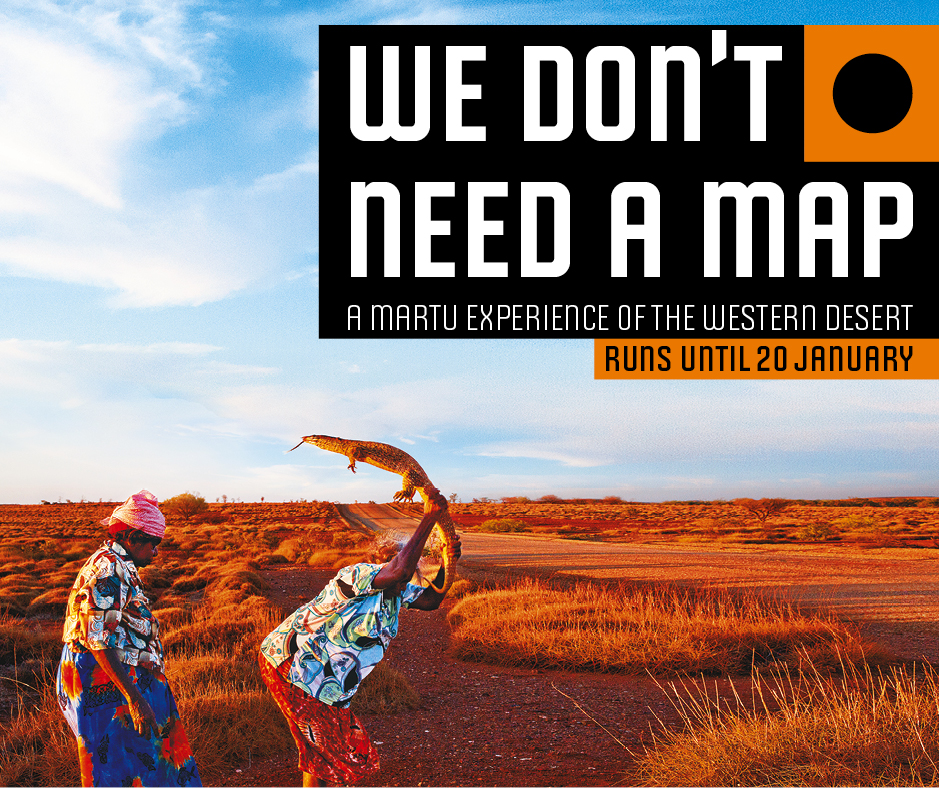We Don’t Need A Map

The concept of territory is a curious thing. It is based neither purely in the physical or the immaterial realms. Instead, ‘territory’ is a mutable concept. It can be composed of the physical, the psychological and/or the political. The exhibition ‘We Don’t Need A Map’ by Martu artists and rangers is an exploration of territory, of ‘country’. This exhibition explores its fixed, tangible and physical aspects and its esoteric connection to ancestry and culture.
In its physicality, i.e. its designation on a map, the territory occupied by Martu people stretches for over 20 million hectares in Western Australia. However, to Martu people, the physicality of the landscape cannot be separated from thousands of years of culture, from the connections to ancestors and Tjukurpa creation beings, from the intimate knowledge of food and water sources and from the bodies of individual Martu people. This complex weaving of physical space and immaterial elements drives this exhibition. ‘We Don’t Need A Map’ attempts to give the viewer a deeper understanding of the intimate knowledge that Martu people have of ‘country’ in all its forms.
However, in the Araluen space it feels like you need a map to scope the entire exhibition with nearly 3 different gallery spaces given over to a wide variety of media. There are beautiful acrylic paintings, high-resolution digital aerial photographs of Martu country, interactive video installations as well works on paper and documentary posters and videos. It is neither purely an art exhibition nor a historical/documentary exhibition. Instead, the exhibition transgresses these boundaries in the same way Martu culture transgresses the physical boundaries of the land. It’s intriguing and interesting, but often messy.
One of the first works encountered is the striking and often gruesome animated video-work “Cannibal Story” by Yunkurra Billy Atkins in collaboration with Sohan Ariel Hayes. While explaining the creation of the land by Tjukurpa ancestors, it also paints Martu country as fraught with danger. This is a curious introduction, but it recognises that beneath everything else (including the beauty of the country that is later interpreted throughout the exhibition in the form of painting and photographic mediums), life is brimming with the potential for danger and death. It also addresses the strength of Martu people and the ability to survive in a landscape (around Lake Disappointment) that seems so hostile to anyone else.
Moving through the exhibition, past the paintings that tell of ancestral stories, the nature of the landscape and those that discuss daily life in the communities, there is a noted amount of collaborative work between Indigenous and non-Indigenous. This includes the mesmerising three channel video “Still Country” by Lynette Wallworth, as well as the “Phone Booth Project” by Martu artist Curtis Taylor and Melbourne’s Lily Hibberd.
In their collaborative nature, they at once examine the many-tiered boundaries between Indigenous and non-Indigenous perspectives of the land and culture and at the same time dissolve these boundaries.
In “Still Country” it is Wallworth’s outsider perspective that is mesmerised by Martu women’s hunting abilities and the gentle but un-sanitized relation to food and survival. In “The Phone Booth Project” Taylor and Hibberd explore the concept of communication through the humble Pilbara community phone booth.
By allowing viewers to participate and immerse themselves in Martu culture, the little idiosyncrasies between cultures dissolve. The intrinsic message becomes clear: everyone has to survive, and everyone wants to communicate in a meaningful way and feel connected and recognised.
This exhibition is filled with many beautiful and ground-breaking works that illuminate so much of Martu culture, but in it’s size and scope it becomes at times overwhelming and confusing. The sights and sounds in the small Araluen galleries compete for attention, and the sheer volume of work included is visually disorientating. Many themes with their highs and lows are explored, but without enough space for serious contemplation before the next concept is considered.
The conceptual territory this exhibition covers is wide and certainly important in educating people about the nuanced and layered relationship between Martu people and ‘country’. But perhaps this exhibition covers too much ground, with too much work in a small space. Perhaps it is I who is still comfortable with carefully delineated boundaries.
Perhaps I am a whitefella who still needs a map.
Karyna is a contributing editor to TheTerritoryInBetween
